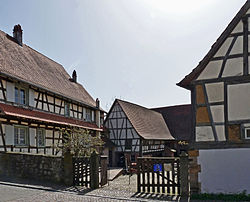Kutzenhausen Kutzehüse | |
|---|---|
 The Maison Rurale de l'Outre-Forêt, an interpretation centre, in Kutzenhausen | |
 Location of Kutzenhausen | |
| Coordinates: 48°56′02″N7°51′23″E / 48.9339°N 7.8564°E | |
| Country | France |
| Region | Grand Est |
| Department | Bas-Rhin |
| Arrondissement | Haguenau-Wissembourg |
| Canton | Reichshoffen |
| Intercommunality | Sauer-Pechelbronn Community of Communes |
| Government | |
| • Mayor (2020–2026) | Pierrot Sitter [1] |
Area 1 | 7.20 km2 (2.78 sq mi) |
| Population (2022) [2] | 924 |
| • Density | 128/km2 (332/sq mi) |
| Time zone | UTC+01:00 (CET) |
| • Summer (DST) | UTC+02:00 (CEST) |
| INSEE/Postal code | 67254 /67250 |
| Elevation | 147–215 m (482–705 ft) |
| Website | www |
| 1 French Land Register data, which excludes lakes, ponds, glaciers > 1 km2 (0.386 sq mi or 247 acres) and river estuaries. | |
Kutzenhausen is a commune in the Bas-Rhin department in Grand Est in north-eastern France. [3]
Contents
- Geography
- Location
- Geology and relief
- Seismicity
- Hydrography
- Climate
- Communications and transport
- Intercommunality
- Town planning
- Typology
- Land use
- Toponymy
- History
- Heraldry
- Politics and administration
- List of mayors
- Budget and taxation 2022
- Economy
- Business and commerce
- Population
- Demographics
- Education
- Health
- Worship
- Twin towns
- Places and monuments
- Religious heritage
- Other heritage
- Personalities linked to the town
- Oldest living people in the town
- Chronological list of the oldest known living person in Kutzenhausen
- See also
- Notes and References
- Notes
- Maps
- References
- External links
Kutzenhausen lies 15 kilometres (9 mi) to the south of Wissembourg, but still within the Parc naturel régional des Vosges du Nord .
This commune is located in the historic and cultural region of Alsace.
















